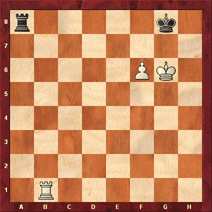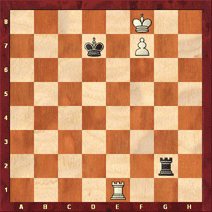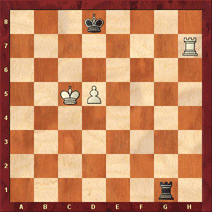Lesson 3: Alpha and Omega
The third chess lesson had an inauspicious start: he had left his chess set at school, and I accidentally left my game printout at work! After we went and got his chess set, we then went and improvised.
First, we looked at the openings. He wants me to follow four rules: knights before bishops, only move the d- and e-pawns, develop kingside pieces first, and move each piece only once. In particular he wants me to stop playing the Bishop's opening and start playing 2. Nf3. This move limits black's options by developing with a threat, gets the knight on a solid square, and leaves you more flexibility in the placement of the light-squared bishop.
I said I liked the Bishop's opening because I use it to transpose into King's Gambit Accepted, which has a similar pawn structure to the Grand Prix Attack. Hence, I am in my comfort zone. He said that at my level I should be doing the exact opposite: playing openings with quite different pawn structures to get a better overall sense of the game of chess. When I said I'd start playing the Ruy in a while, after I had some practice in blitz, he said to just start playing it, as that's the best way to learn it. While this all goes against my cautious nature, I'm gonna take his advice since I've committed to using him as my coach and seeing where it leads me. If my rating takes a temporary hit, so be it.
On to the omega, the endgame, where we finished our study of rook and (one) pawn endgames which we began in our first lesson. I felt like an idiot through much of this: some of the moves are just not obvious! Basically, he wants me to learn four rook and pawn endgame positions. Really well. He said once I can do these positions (and not just literally these positions, but also knowing how little variations affect things), once I can recognize them cold, I will have the basics down, which should be more than enough for me right now. The four positions are:
1) The encircling maneuver
 White to play and win.
White to play and win.
2) The Philidor position
 Black to move and draw. Muller and Lamprecht, in Fundamental Chess Endings call this "the most important position in the whole book."
Black to move and draw. Muller and Lamprecht, in Fundamental Chess Endings call this "the most important position in the whole book."
3) The Lucena position
 White to move and win. Silman calls this position "the sacred key to all rook endings."
White to move and win. Silman calls this position "the sacred key to all rook endings."
4) Lasker 1925
 White to move, play as black to draw. This position is very tricky. Jon said that many GMs don't know how to draw as black in this position, and that a deep understanding of all its variations will illustrates all of the major themes we have worked on.
White to move, play as black to draw. This position is very tricky. Jon said that many GMs don't know how to draw as black in this position, and that a deep understanding of all its variations will illustrates all of the major themes we have worked on.
My work is cut out for me.
First, we looked at the openings. He wants me to follow four rules: knights before bishops, only move the d- and e-pawns, develop kingside pieces first, and move each piece only once. In particular he wants me to stop playing the Bishop's opening and start playing 2. Nf3. This move limits black's options by developing with a threat, gets the knight on a solid square, and leaves you more flexibility in the placement of the light-squared bishop.
I said I liked the Bishop's opening because I use it to transpose into King's Gambit Accepted, which has a similar pawn structure to the Grand Prix Attack. Hence, I am in my comfort zone. He said that at my level I should be doing the exact opposite: playing openings with quite different pawn structures to get a better overall sense of the game of chess. When I said I'd start playing the Ruy in a while, after I had some practice in blitz, he said to just start playing it, as that's the best way to learn it. While this all goes against my cautious nature, I'm gonna take his advice since I've committed to using him as my coach and seeing where it leads me. If my rating takes a temporary hit, so be it.
On to the omega, the endgame, where we finished our study of rook and (one) pawn endgames which we began in our first lesson. I felt like an idiot through much of this: some of the moves are just not obvious! Basically, he wants me to learn four rook and pawn endgame positions. Really well. He said once I can do these positions (and not just literally these positions, but also knowing how little variations affect things), once I can recognize them cold, I will have the basics down, which should be more than enough for me right now. The four positions are:
1) The encircling maneuver
 White to play and win.
White to play and win.2) The Philidor position
 Black to move and draw. Muller and Lamprecht, in Fundamental Chess Endings call this "the most important position in the whole book."
Black to move and draw. Muller and Lamprecht, in Fundamental Chess Endings call this "the most important position in the whole book."3) The Lucena position
 White to move and win. Silman calls this position "the sacred key to all rook endings."
White to move and win. Silman calls this position "the sacred key to all rook endings."4) Lasker 1925
 White to move, play as black to draw. This position is very tricky. Jon said that many GMs don't know how to draw as black in this position, and that a deep understanding of all its variations will illustrates all of the major themes we have worked on.
White to move, play as black to draw. This position is very tricky. Jon said that many GMs don't know how to draw as black in this position, and that a deep understanding of all its variations will illustrates all of the major themes we have worked on.My work is cut out for me.
8 Comments:
John is right - lots of GM's don't know endgames and especially number 4, but everything I've read says that it's mostly Western players - the Eastern bloc players have this drilled into them cold.
The position that GMs can't solve-
From this we may conclude that it is very common to become a GM without being able to solve this particular kind of problem. Therefore, better to spend time on those positions that you REALLY need to know how to solve to become a GM.
I am half-joking.
Who has the key, critical positions- the "GM RAM" guy ( Rashid Niatdinov) or maybe Lev Alburt's 300 key positions?
IMHO, King and pawn endgames are even more critical than rook endgames, and they are the fundamental building block for other endgames.
Funky: Jesse Kreil and Silman think the Philidor and Lucena are all you need to know about rook and pawn. Kreil thinks just knowing those two positions are sufficient for players under 2000.
I think picking a random problem a GM can't solve is one thing, but he has chosen this particular problem because of its instructive value (it leads to Philidor, but also to Lucena if black mis-steps, shows the power of rooks staying on the long side, king on the short side, etc).
As for what is most critical, don't rook and pawn endings make up 50% of endings in practice? King and pawn is so damned BORING, but admittedly very tricky. That's my next target after this. I'll be posting more about endgames: I've found the ultimate endgame book.
King and pawn endgames might look boring in a textbook, but in a real game, when the slightest counting error in a dead-even position can lose on the spot, I am anything but bored.
Since you're all into endgames right now, i'd like to point out a very usefull endgame book for on the go (it's pocketsize), written by GM Neil McDonald. I just got one myself :-)
I also got the one on the middlegame while i was at it. There's also one on the opening, but after searching for some reviews on it, it did not look all that good. Check it out here.
Btw, what's that ultimate endgame book you found? And what's up with your blog fantom? Or am i the only one that is not able to visit it?
Edwin: that looks cool. I am saturated with endgame books at this point. I need to read at least one of them. :)
I'll post about the greatest endgame book of all time soon...At least that's what the book flap says. :O
"I'll post about the greatest endgame book of all time soon...At least that's what the book flap says. :O"
Silman's new endgame book (??)
Just to hazard a guess.
Patrick wins a cigar! The new post is now up.
Post a Comment
<< Home